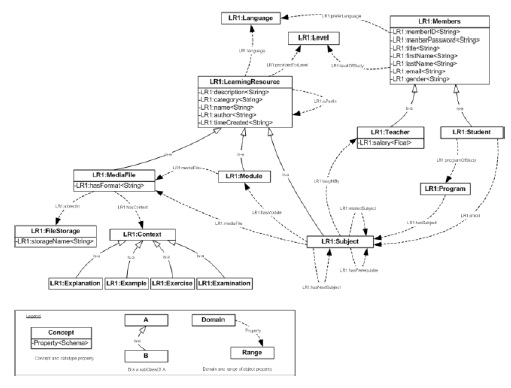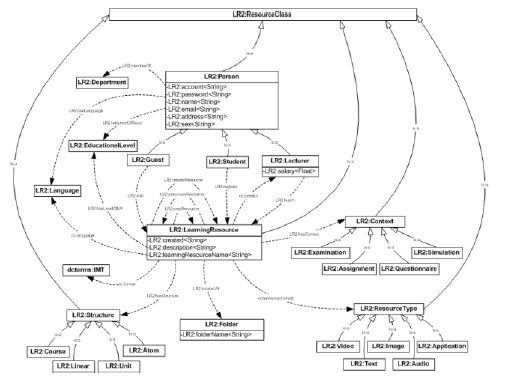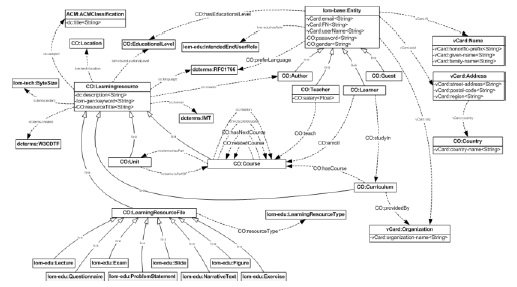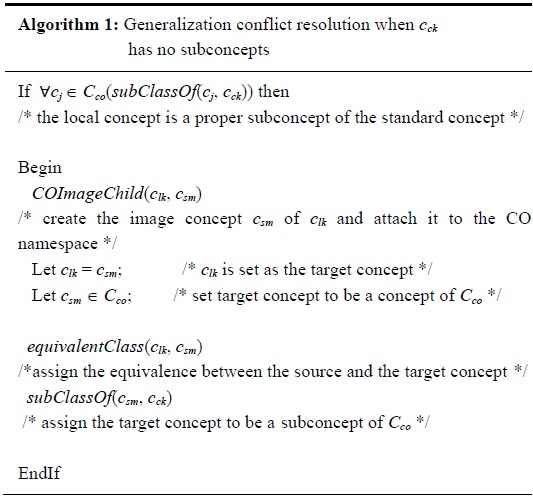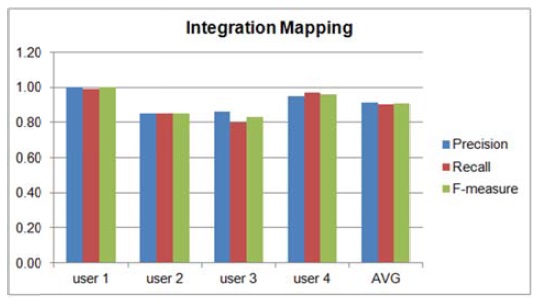



With the increasing demand for interoperability among existing learning resource systems in order to enable the sharing of learning resources, such resources need to be annotated with ontologies that use different metadata standards. These different ontologies must be reconciled through ontology mediation, so as to cope with information heterogeneity problems, such as semantic and structural conflicts. In this paper, we propose an ontology-mapping technique using Semantic Web Rule Language (SWRL) to generate semantic mapping rules that integrate learning resources from different systems and that cope with semantic and structural conflicts. Reasoning rules are defined to support a semantic search for heterogeneous learning resources, which are deduced by rule-based inference. Experimental results demonstrate that the proposed approach enables the integration of learning resources originating from multiple sources and helps users to search across heterogeneous learning resource systems.
Owing to the rapid growth of e-learning communities, several educational institutions have developed a variety of learning management systems (LMSs) independently, which they have constructed based on their own functional requirements. Therefore, there is a rapidly increasing number of duplicate learning resources (LRs) published on different sites. Metadata plays a crucial role in describing the content of such LRs and in facilitating their integration, to enable the reusability and exchangeability of existing LRs in different LMSs. The use of different types of metadata still results in a problem of interoperability across heterogeneous LRs. Furthermore, most of these metadata standards lack formal semantics and a common standard between heterogeneous metadata descriptions across domains.
Until recently, a number of researchers [1,2] have used metadata standards and ontologies to semantically annotate LRs; this can easily increase discovery and reuse, and facilitate sharing of LRs among LMSs. Several studies of LR sharing using ontology mapping have been performed [3,4]. Despite wide acceptance, however, the problems of semantic interoperability and semantic discovery across heterogeneous LMSs still have the potential to cause difficulties in sharing available LRs. The meaning of the information described and the differences in design among information systems lead to
1)
2)
To address the problems above, we propose a method of resolution for issues of heterogeneity using ontology mapping extended from our previous work [7-9]. We have applied SWRL to solve the problem of ontology mapping, especially in the case of structural conflicts, for which Web Ontology Language (OWL) has a limited capability.
The remainder of the paper is structured as follows: Section II illustrates heterogeneity problems with a motivating example. Section III describes the design of the common ontology that was used in most of this work to overcome the problems outlined above. The ontology mapping for integration is presented in Section IV. Section V presents experimental results obtained via the system implementation and evaluation of the proposed mapping technique. Finally, our conclusions and suggestions for future work are summarized in Section VI.
To illustrate the information heterogeneity problems that exist in most e-learning systems, we demonstrate here how two different LR ontologies can extract only a portion of the learning-content resources from distinct LMS repositories. The ontologies are referred to as LR1 and LR2, and are shown in Figs. 1 and 2, respectively.
Semantic heterogeneity occurs when there is a disagreement about the meaning, interpretation, or intended use of the same or related data [10,11]. Semantic heterogeneity is classified into three types: naming conflicts, scaling conflicts, and property value conflicts. These types are described below.
Structural heterogeneity occurs when the same concepts are modelled with different logical structures in different systems. Although there are several publications that classify structural heterogeneity into various types of conflicts [5,6,10,11], this paper focuses on four main kinds of such conflicts, as described below.
To overcome heterogeneity problems, we designed the Common Ontology (CO) as a standard mediatory ontology for supporting the integration. The CO was defined using basic terms based on standard metadata for e-learning. The two common standards, namely DC and LOM, are included. These standards are aimed at enabling usability, aiding discoverability, and facilitating interoperability, usually in the context of online LMSs. Terminology outside this common vocabulary must be translated to the terminology of the metadata standard; otherwise, a comparison of data semantics will not be possible. In this paper, the common terms that cannot be described with the DC and LOM vocabularies are prefixed with the namespace
The CO structure consists of standard concepts and standard properties. The standard concepts include, for example,
The standard properties are the datatype property and the object property. A datatype property, such as
This section describes the method of conflict detection and resolution for overcoming the problems mentioned in Section II. The conflict detection method is presented in the form of rules and algorithms, whereas the resolution method is presented as mapping rules, which are used to map between any local ontology and the CO. In our approach, LR1 and LR2 must be mapped into a standard-related entity in the CO. Thus, both ontologies have already conducted sharing of their LRs with the CO. In view of this, after mapping has been performed from LR1 and LR2 to the CO, LR1 can map the semantic entities of LR2 automatically, because it knows about their mapping to a common schema from the CO. This will become increasingly beneficial as more educational content providers begin to use the CO for global sharing of a standard mapping to their repositories.
The following definitions are general notations for the CO components. They are represented on the basis of object-oriented programming and set theory.
DEFINITION 1.
DEFINITION 2.
DEFINITION 3.
DEFINITION 4.
DEFINITION 5.
DEFINITION 6.
DEFINITION 7.
DEFINITION 8.
The following functions define the domain, range, and type of the common properties.
Γ:
If then Γ(
DEFINITION 9. An ontology mapping, denoted by
The conflict detection rules and the mapping rules are defined in the following sections.
>
B. Conflict Detection and Resolution
1) Resolution for Semantic Heterogeneity
Rule 1: If the similarity score of two terms is equal to 1, then the two terms are equivalent, i.e.
A term
The mapping rules for resolving the conflict in other cases are as below, where
Mapping Rule 1:
Case 1:
Case 2:
Rule 2: If the two scaling units are in conflict, then the local unit needs to be converted to the standard unit as in the CO.
A local literal value
Mapping Rule 2:
The property
The following mapping rule applies Mapping Rule 2 to resolve the scaling conflict occurring in
Rule 3: If the values,
In this resolution, we apply SWRL to convert the
Mapping Rule 3:
where “
The resolution of the conflicts in the case study is presented below:
2) Resolution for Semantic Heterogeneity
Case 1: A standard concept
Rule 4: If a concept
Mapping Rule 4: The concept
Case 2: A standard concept
Rule 5: If a concept
Mapping Rule 5: If a concept
After Mapping Rule 5 has been applied, the concept
Rule 6: If a property in one ontology is similar to a group of properties in another ontology, then it can be mapped to that group of properties in the other ontology, as follows.
Since a group of properties
Mapping Rule 6:
Rule 7: If two equivalent properties have different property types, then the type of the local property Γ(
Mapping Rule 7 resolves the difference between Γ(
Mapping Rule 7:
Note that the concept
Rule 8: If a set of properties and values of a concept in one system is similar to that of a concept in another system, but they have different structures, then the values of the properties in one ontology can be organized as a set of instances of an identical concept in another ontology using a specific restriction, as follows.
Mapping Rule 8 below is used to map
Mapping Rule 8:
In our experiments, we used LRs from the Moodle LMSs of two different universities as a set of instances for testing. One of these data sources originated from the Department of Computer Science, Khon Kaen University, Thailand, and the other from the Faculty of Computer Science, Ubon Ratchathani Rajabhat Univ ersity, Thailand. The first source contained six undergraduate and six graduuate courses, while the second contained eight undergraduate and three graduate courses. We implemented a system called ‘OWLGenerator’ to extract database tuples from the LMSs into the ontological instances. The first source was mapped to LR1, and the second source was mapped to LR2. The instances of each local ontology were integrated into the CO through the ontology-mapping process.
To demonstrate how the rules resolved problems, a system named the Learning Resource Integration System (LRIS) was developed to evaluate the proposed approach. The system provided basic and advanced search capabilities. It allowed users to search for LRs and retrieved the results based on the inference rules. We used the advanced search module of the LRIS to execute SPARQL commands to query the LRs across heterogeneous ontologies. The query was to select the LRs that contained the keyword ‘program’ in the resource title, as shown in the following:
Fig. 4 deppicts an excerpt from the list of LRs and properties retrieved from the LR1 and LR2 sources. The results were inferred by use of Mapping Rules 1 and 3 and represent the LR properties corresponding to the query.
To validate the system, three techniques which are considered standard information retrieval metrics [14], namely precision, recall, and F-measure, can be used to evaluate the results of different approaches to information retrieval; they are widely accepted in the evaluation of ontology mapping [15]. The F-measure is a combination of the precision and recall measures. The formulas are as below:
The LRIS was tested by four service requesters (users), i.e. authors, teachers, learners, and guests, who searched for LRs across different LMSs. The results retrieved were then evaluated using the three metrics. Each user executed 30 queries to retrieve the results. The results are shown in Fig. 5.
VI. CONCLUSIONS AND FUTURE WORK
In this paper, we have proposed a methodology for the integration of LRs for semantic search using ontology mapping and rule-based inference. The proposed approach focuses mainly on addressing the problem of heterogeneity, including both semantic and structural conflicts. The standard CO was designed for a global shared ontology for overcoming the heterogeneity problems among different LMSs. Reasoning rules to cope with the problems were defined using SWRL. The LRIS application for LR discovery was developed in order to evaluate the proposed approach. Experimental results have shown that our proposed approach performs effectively. Moreover, the proposed rules also allow other approaches to be incorporated, despite the existence of distinct platforms and data heterogeneities. The application of a metadata-based ontology enables us to achieve a higher level of interoperability and greater practicability in e-learning domains.
However, the ability of our approach to resolve more complex problems is still limited. The mapping process is not fully automatic. Some conflicts require a domain expert to detect and resolve them manually. Modelling of mediator ontologies has been investigated mainly in the context of its application to e-learning, and does not cover other domains. In future work, we intend to improve the mediator ontology in order to support different educational systems. The semi-automatic mapping tool must be enhanced to support the mapping process. Moreover, more conflict resolution needs to be performed in future work.
